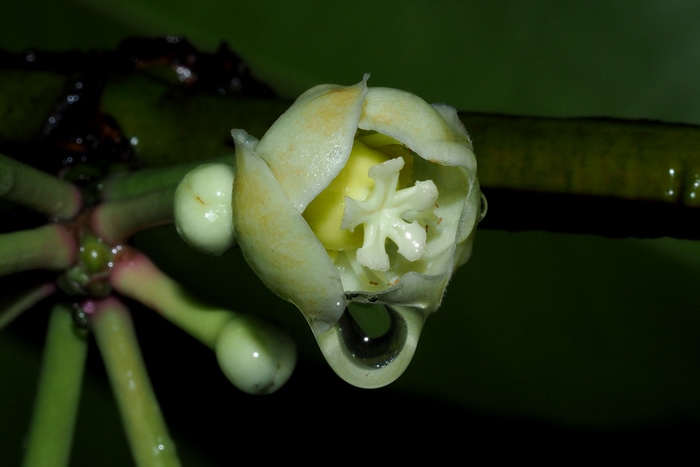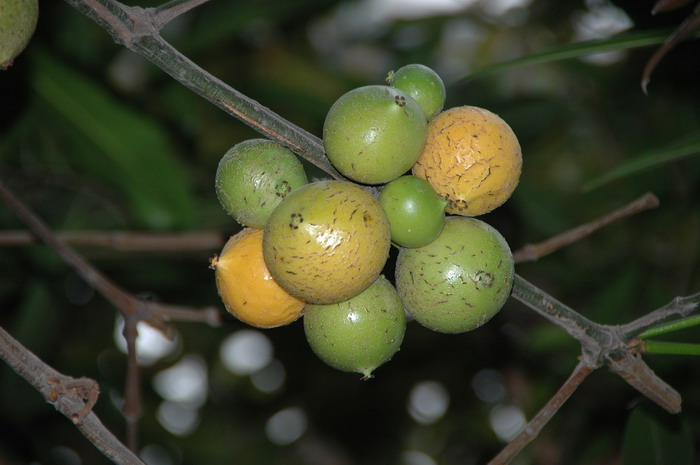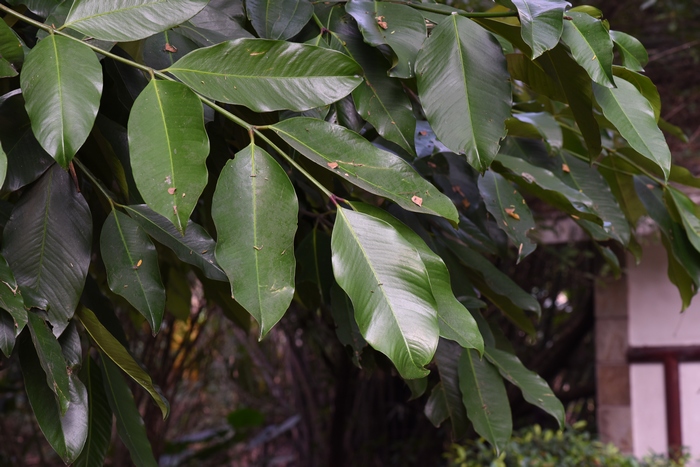大叶藤黄Garcinia xanthochymus
中文名(Chinese Name):大叶藤黄
学名(Scientific Name):Garcinia xanthochymus Hook. f. ex T. Anderson
英文名(English Common Name):garcinia
别名(Chinese Common Name):人面果、岭南倒捻子
异名(Synonym):Xanthochymus pictorius Roxb. Xanthochymus tinctorius DC. Stalagmitis pictoria G.Don
科属(Family & Genus):藤黄科(Guttiferae)藤黄属
形态特征(Description):乔木,高8-20米,胸径15-45厘米,树皮灰褐色,分枝细长,多而密集,平伸,先端下垂,通常披散重叠,小枝和嫩枝具明显纵稜。叶两行排列,厚革质,具光泽,椭圆形、长圆形或长方状披针形,长(14-)20-34厘米,宽(4-)6-12厘米,顶端急尖或钝,稀渐尖,基部楔形或宽楔形,中脉粗壮,两面隆起,侧脉密集,多达35-40对,网脉明显;叶柄粗壮,基部马蹄形,微抱茎,枝条顶端的1-2对叶柄通常玫瑰红色,长1.5-2.5厘米,干后有稜及横皱纹。伞房状聚伞花序,有花(2-)5-10(-14)朵,腋生或从落叶叶腋生出总梗长约6-12毫米;花两性,5数,花梗长1.8-3厘米;萼片和花瓣3大2小,边缘具睫毛;雄蕊花丝下部合生成5束,先端分离,分离部份长约3毫米,扁平,每束具花药2-5,基部具方形腺体5枚,腺体顶端有多数孔穴,长约1毫米,与萼片对生;子房圆球形,通常5室,花柱短,约1毫米,柱头盾形,中间凹陷,通常深5裂,稀4或3裂,光滑。浆果圆球形或卵球形,成熟时黄色,外面光滑,有时具圆形皮孔,顶端突尖,有时偏斜,柱头宿存,基部通常有宿存的萼片和雄蕊束。种子1-4,外面具多汁的瓢状假种皮,长圆形或卵球形,种皮光滑,棕褐色。花期3-5月,果期8-11月。
分布(Distribution):产云南及广西,生于海拔100-1400米沟谷和丘陵地潮湿的密林中。喜马拉雅山,孟加拉东部经缅甸、泰国至中南半岛及安达曼岛也有。
用途(Use):果成熟后可食用,其味较酸;种子含油量17.72%,可作工业用油
引自中国植物志英文版FOC Vol. 13 Page 41, 42
Garcinia xanthochymus J. D. Hooker ex T. Anderson in J. D. Hooker, Fl. Brit. India. 1: 269. 1874.
大叶藤黄 da ye teng huang| Clusiaceae | Garcinia
Garcinia pictoria (Roxburgh) Engler (1925), not Buchanan-Hamilton (1826); G. tinctoria W. Wight (1909); G. tinctoria (Candolle) Dunn (1915); Xanthochymus pictorius Roxburgh; X. tinctorius Candolle.
Trees 8-10 m tall, 15-45 cm in diam. Bark gray-brown. Branches numerous, slender, decussate, horizontal but usually ± distally pendulous, twigs distinctly angled. Petiole robust, V-shaped and somewhat clasping at base, 1.5-2.5 cm, angled and transversely wrinkled when dry, those of terminal 1 or 2 pairs on branchlet usually rose-colored; leaf blade shiny, elliptic or oblong to oblong-lanceolate, (14-)20-34 × (4-)6-12 cm, thickly leathery, midvein robust, raised on both surfaces; veins dense, to 35-40 pairs, near margin arching and anastomosing; tertiary veins and veinlets conspicuous, base ± broadly cuneate, margin involute, apex acute to obtuse, rarely acuminate. Corymbose cyme (2-)5-10(-14)-flowered, arising from leafless axils; peduncle 6-12 mm. Pedicels 1.8-3 cm. Flowers 5-merous, only female observed. Sepals and petals 3 large and 2 small, apparently ciliate. Staminode fascicles 5, ca. 3 mm, complanate, united below, upper parts free, each fascicle with 2-5 staminodes; fasciclodes 5, square, ca. 1 mm, strongly rugose. Ovary globose, usually 5-loculed; style short, ca. 1 mm; stigma peltate, apex concave, (3-)5-cleft. Mature berry yellow, globose or ovoid, sometimes oblique, 3-5 cm in diam., smooth or sometimes with orbicular lenticels, apiculate, sepals and staminal bundles usually persistent. Seeds 1-4, oblong or ovoid; testa brown, smooth. Fl. Mar-May, fr. Aug-Nov. 2n = 72, 80, 96.
Dense humid forests of valleys or on hills; (100-)600-1000(-1400) m. Guangdong (cultivated), SW Guangxi, S, SW, and W Yunnan [Bangladesh, Bhutan, Cambodia, India, Japan (introduced and cultivated), Laos, Myanmar, Nepal, Thailand, Vietnam].
The fruit is edible but is rather sour. The seeds yield up to 17% oil.
Some scholars have reduced Garcinia pictoria Buchanan-Hamilton (Mem. Wern. Nat. Hist. Soc. 5: 346. 1826) to this species; however, G. pictoria Buchanan-Hamilton has 4-merous, solitary, sessile flowers, 4-cleft stigmas, and 4-angled fruit, so it is regarded as distinct.



(责任编辑:徐晔春)
学名(Scientific Name):Garcinia xanthochymus Hook. f. ex T. Anderson
英文名(English Common Name):garcinia
别名(Chinese Common Name):人面果、岭南倒捻子
异名(Synonym):Xanthochymus pictorius Roxb. Xanthochymus tinctorius DC. Stalagmitis pictoria G.Don
科属(Family & Genus):藤黄科(Guttiferae)藤黄属
形态特征(Description):乔木,高8-20米,胸径15-45厘米,树皮灰褐色,分枝细长,多而密集,平伸,先端下垂,通常披散重叠,小枝和嫩枝具明显纵稜。叶两行排列,厚革质,具光泽,椭圆形、长圆形或长方状披针形,长(14-)20-34厘米,宽(4-)6-12厘米,顶端急尖或钝,稀渐尖,基部楔形或宽楔形,中脉粗壮,两面隆起,侧脉密集,多达35-40对,网脉明显;叶柄粗壮,基部马蹄形,微抱茎,枝条顶端的1-2对叶柄通常玫瑰红色,长1.5-2.5厘米,干后有稜及横皱纹。伞房状聚伞花序,有花(2-)5-10(-14)朵,腋生或从落叶叶腋生出总梗长约6-12毫米;花两性,5数,花梗长1.8-3厘米;萼片和花瓣3大2小,边缘具睫毛;雄蕊花丝下部合生成5束,先端分离,分离部份长约3毫米,扁平,每束具花药2-5,基部具方形腺体5枚,腺体顶端有多数孔穴,长约1毫米,与萼片对生;子房圆球形,通常5室,花柱短,约1毫米,柱头盾形,中间凹陷,通常深5裂,稀4或3裂,光滑。浆果圆球形或卵球形,成熟时黄色,外面光滑,有时具圆形皮孔,顶端突尖,有时偏斜,柱头宿存,基部通常有宿存的萼片和雄蕊束。种子1-4,外面具多汁的瓢状假种皮,长圆形或卵球形,种皮光滑,棕褐色。花期3-5月,果期8-11月。
分布(Distribution):产云南及广西,生于海拔100-1400米沟谷和丘陵地潮湿的密林中。喜马拉雅山,孟加拉东部经缅甸、泰国至中南半岛及安达曼岛也有。
用途(Use):果成熟后可食用,其味较酸;种子含油量17.72%,可作工业用油
引自中国植物志英文版FOC Vol. 13 Page 41, 42
Garcinia xanthochymus J. D. Hooker ex T. Anderson in J. D. Hooker, Fl. Brit. India. 1: 269. 1874.
大叶藤黄 da ye teng huang| Clusiaceae | Garcinia
Garcinia pictoria (Roxburgh) Engler (1925), not Buchanan-Hamilton (1826); G. tinctoria W. Wight (1909); G. tinctoria (Candolle) Dunn (1915); Xanthochymus pictorius Roxburgh; X. tinctorius Candolle.
Trees 8-10 m tall, 15-45 cm in diam. Bark gray-brown. Branches numerous, slender, decussate, horizontal but usually ± distally pendulous, twigs distinctly angled. Petiole robust, V-shaped and somewhat clasping at base, 1.5-2.5 cm, angled and transversely wrinkled when dry, those of terminal 1 or 2 pairs on branchlet usually rose-colored; leaf blade shiny, elliptic or oblong to oblong-lanceolate, (14-)20-34 × (4-)6-12 cm, thickly leathery, midvein robust, raised on both surfaces; veins dense, to 35-40 pairs, near margin arching and anastomosing; tertiary veins and veinlets conspicuous, base ± broadly cuneate, margin involute, apex acute to obtuse, rarely acuminate. Corymbose cyme (2-)5-10(-14)-flowered, arising from leafless axils; peduncle 6-12 mm. Pedicels 1.8-3 cm. Flowers 5-merous, only female observed. Sepals and petals 3 large and 2 small, apparently ciliate. Staminode fascicles 5, ca. 3 mm, complanate, united below, upper parts free, each fascicle with 2-5 staminodes; fasciclodes 5, square, ca. 1 mm, strongly rugose. Ovary globose, usually 5-loculed; style short, ca. 1 mm; stigma peltate, apex concave, (3-)5-cleft. Mature berry yellow, globose or ovoid, sometimes oblique, 3-5 cm in diam., smooth or sometimes with orbicular lenticels, apiculate, sepals and staminal bundles usually persistent. Seeds 1-4, oblong or ovoid; testa brown, smooth. Fl. Mar-May, fr. Aug-Nov. 2n = 72, 80, 96.
Dense humid forests of valleys or on hills; (100-)600-1000(-1400) m. Guangdong (cultivated), SW Guangxi, S, SW, and W Yunnan [Bangladesh, Bhutan, Cambodia, India, Japan (introduced and cultivated), Laos, Myanmar, Nepal, Thailand, Vietnam].
The fruit is edible but is rather sour. The seeds yield up to 17% oil.
Some scholars have reduced Garcinia pictoria Buchanan-Hamilton (Mem. Wern. Nat. Hist. Soc. 5: 346. 1826) to this species; however, G. pictoria Buchanan-Hamilton has 4-merous, solitary, sessile flowers, 4-cleft stigmas, and 4-angled fruit, so it is regarded as distinct.


(责任编辑:徐晔春)
踩一下[0]

顶一下[0]